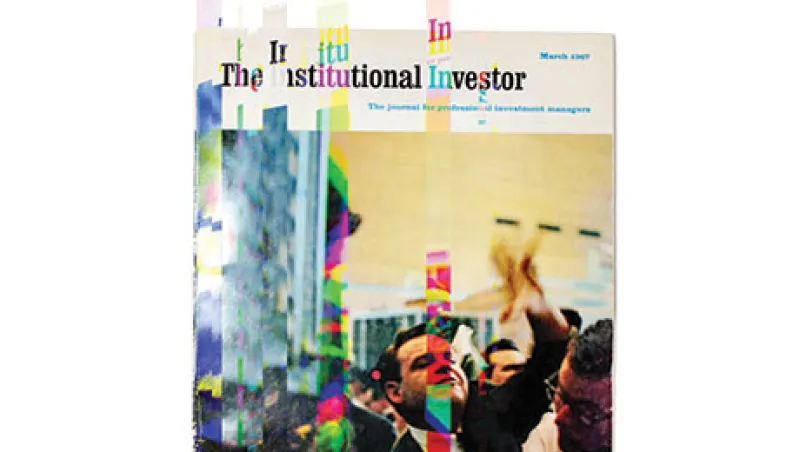The Cambrian explosion has nothing on institutional investing.
In the former, half a billion years ago, the complexity of life increased by orders of magnitude over millions of years. Institutional investing’s journey from small and simple to enormously complex took only half a century.
Many benefited from this veritable explosion, as detailed in this 50th-anniversary issue.
Businesses, especially those with less-than-stellar credit ratings, owe a debt of gratitude to Michael Milken — the man who contributor William D. Cohan profiles here and who has so successfully reinvented himself after a two-year prison sentence following the excess of the 1980s.
Start-ups and dreamers, in Silicon Valley and worldwide, have ridden the wave of greatly expanded venture capital and private equity — an industry profiled by Jess Delaney in our May print edition and one whose future will be as interesting as its past.
Perhaps most of all, asset allocators the world over benefited endlessly from a growing range of investable options that went from absolutely basic to the exact opposite — an evolution detailed in this month's issue of Institutional Investor Magazine.
And not least, there are those who manage other people’s money for a fee. In 1982, the inaugural Forbes 400 list of wealthy Americans contained just one person in the top 100 who made his money that way: Warren Buffett, at No. 92 (and even that was a stretch, as Buffett had stopped managing other people’s money for a fee long before). In 2016, counting just those who could be said to have gotten wealthy via fee-based money management, there were 12: George Soros, James Simon, Ray Dalio, Carl Icahn, Abigail Johnson, Steven Cohen, David Tepper, Stephen Schwarzman, John Paulson, Ken Griffin, Edward Johnson III, and Bruce Kovner. A number of these individuals — along with a litany of other financiers, academics, politicians, allocators, and villains — made the Institutional Investor 50, our list of the most impactful (good and bad) individuals in institutional investment over the past five decades.
And yet for all structured products, junk bonds, derivatives, risk measures, alternatives, hedges, and swaps that have sprung up since Gil Kaplan founded this magazine in 1967, the underlying goal of institutional investing is almost entirely the same: Companies need capital; allocators demand return on capital. Investment bankers act as the grease; asset managers, I daresay, are either reliable stewards or degenerate gamblers. This Rube Goldberg machine that is the financial system, despite its ludicrous complexity, still does the same thing it did 50 years ago.
The unfortunate and ironic part is that all this innovation has done little to quell crises. Economic collapses occurred before the institutional investing Cambrian explosion, and they happened after. For every tulip craze, Charles Ponzi, and Great Depression, the past 50 years have seen just as many housing bubbles, Bernie Madoffs, and economic downturns. Underlying every instance of disaster is the same root: We simply do not know what we think we know.
Which is why the most recent craze in institutional investing leaves me lukewarm. In March, BlackRock announced that it was “reorienting” many of its active equity strategies toward a computer-driven, quantitative approach. Firms such as James Simons’ Renaissance Technologies have been relying on computer-driven returns for more than three decades, and BlackRock’s move all but makes quantitative investing the default. Out with the green eyeshade, in with the monotonous drone of server farms.
The problem is that the laymen — and, relative to the James Simonses of the world, we are almost all laymen — must put blind faith in computers. No matter how smart, no one outside Renaissance Technologies understands what is in its black box; the few outside investors that remain simply must hope the box still produces, and collect their returns when it does.
BlackRock isn’t becoming Renaissance, of course. Yet the firm’s plan of “harnessing the power of human and machine to efficiently and consistently deliver investment performance” is, at its core, a denunciation of the human brain. Peter Lynch — the great mutual fund manager of Magellan Fund fame — recently told me, “An investment needs a story.” Explaining why you expect an investment to go up or down is an essential step for an investor, he said, even if you’re right only 60 percent of the time.
Now, instead of Lynch’s homespun narratives, we will increasingly hear one phrase: “Because the computer said so” — an admission, at its core, that we don’t understand.
I was born the same year as Renaissance; I am more than ready for self-driving cars, robo-advisors, and augmented reality. I believe wholeheartedly in the positive message laid out in the first sentences written in Institutional Investor by our founder, Gil Kaplan: “The management of money is one of the oldest of the arts and one of the newest of professions. As a profession, it is changing continuously, so much so that it bears little resemblance to the same field only a generation ago.”
But we must not mistake complexity for certainty. We will face more crises, more Ponzis, more crazes, all the result of not knowing what we thought we knew.
It will be up to humans, not algorithms, to dig us out.
Kip McDaniel is the Editorial Director and Chief Content Officer of Institutional Investor.






